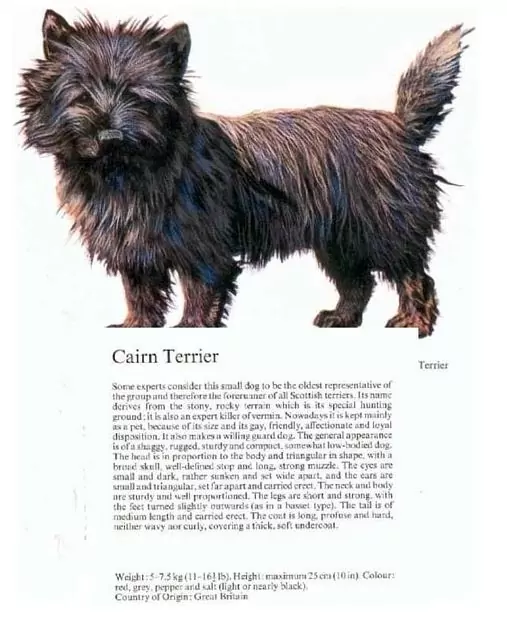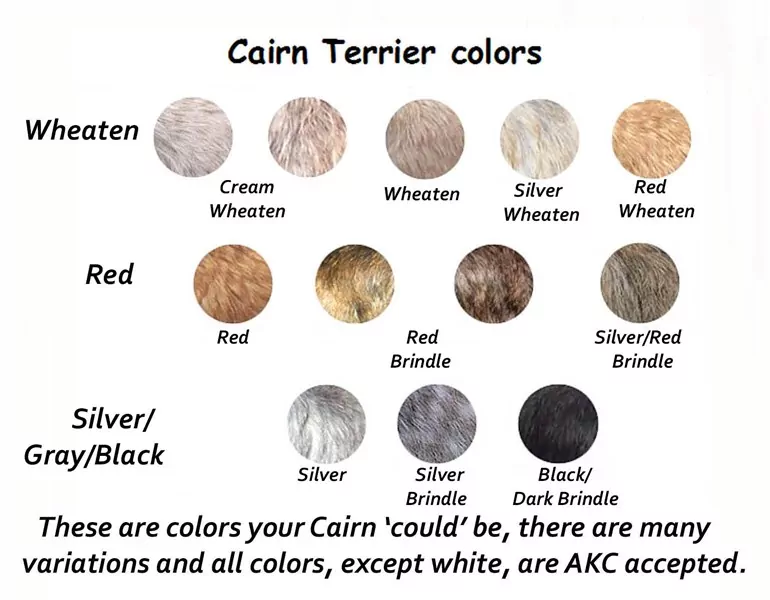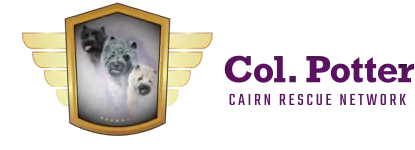AKC Information
The Cairn Terrier is indeed recognized as a breed by the AKC (American Kennel Club). The AKC is a reputable organization that registers purebred dogs and promotes responsible dog ownership. Cairn Terriers are classified as a member of the Terrier Group by the AKC.

The U.S. Cairn Terrier Standard
Approved May 10, 1938
That of an active, game, hardy, small working terrier of the short-legged class; very free in its movements, strongly but not heavily built, standing well forward on its forelegs, deep in the ribs, well coupled with strong hindquarters and presenting a well-proportioned build with a medium length of back, having a hard, weather-resisting coat; head shorter and wider than any other terrier and well furnished with hair giving a general foxy expression.
Skull: Broad in proportion to length with a decided stop and well furnished with hair on the top of the head, which may be somewhat softer than the body coat.
Muzzle: Strong but not too long or heavy.
Teeth: Large, mouth neither overshot nor undershot.
Nose: Black.
Eyes: Set wide apart, rather sunken, with shaggy eyebrows, medium in size, hazel or dark hazel in color, depending on body color, with a keen terrier expression.
Ears: Small, pointed, well carried erectly, set wide apart on the side of the head. Free from long hairs.
In proportion to head, well furnished with hair but not feathery. Carried gaily but must not curl over back. Set on at back level.
Well-muscled, strong, active body with well-sprung, deep ribs, coupled to strong hindquarters, with a level back of medium length, giving an impression of strength and activity without heaviness.
A sloping shoulder, medium length of leg, good but not too heavy bone; forelegs should not be out at elbows, and be perfectly straight, but forefeet may be slightly turned out. Forefeet larger than hind feet. Legs must be covered with hard hair. Pads should be thick and strong and dog should stand well up on its feet.
May be of any color except white. Dark ears, muzzle and tail tip are desirable.

Involves the weight, the height at the withers and the length of body. Weight for bitches, 13 pounds; for dogs, 14 pounds. Height at the withers: bitches, 9-1/2 inches; dogs, 10 inches. Length of body from 14-1/4 to 15 inches from the front of the chest to back of hindquarters. The dog must be of balanced proportions and appear neither leggy nor too low to ground; and neither too short nor too long in body. Weight and measurements are for matured dogs at two years of age. Older dogs may weigh slightly in excess and growing dogs may be under these weights and measurements.
**Rescue note: This standard is from 1930. For the purpose of considering a rescue dog, it must be stated that many Cairns bred today exceed the height and weight listed above.
Dogs should be shown in good hard flesh, well muscled and neither too fat or thin. Should be in full good coat with plenty of head furnishings, be clean, combed, brushed and tidied up on ears, tail, feet and general outline. Should move freely and easily on a loose lead, should not cringe on being handled, should stand up on their toes and show with marked terrier characteristics.
- Skull: Too narrow in skull.
- Muzzle: Too long and heavy a foreface; mouth overshot or undershot.
- Eyes: Too large, prominent, yellow, and ringed are all objectionable.
- Ears: Too large, round at points, set too close together, set too high on the head; heavily covered with hair.
- Legs and Feet: Too light or too heavy bone. Crooked forelegs or out at elbow. Thin, ferrety feet; feet let down on the heel or too open and spread. Too high or too low on the leg.
- Body: Too short back and compact a body, hampering quickness of movement and turning ability. Too long, weedy and snaky a body, giving an impression of weakness. Tail set on too low. Back not level.
- Coat: Open coats, blousy coats, too short or dead coats, lack of sufficient undercoat, lack of head furnishings, lack of hard hair on the legs. Silkiness or curliness. A slight wave permissible.
- Nose: Flesh or light-colored nose.
- Color: White on chest, feet or other parts of body.
ANGULATION: The angles formed by the meeting of the bones. Mainly the shoulder, upper arm, stifle and hock.
APRON: Longer hair below the neck on the chest. Frill
BACKSKULL: That portion of the skull between the stop and the ears.
BARRELL: Rounded rib section; thorax.
BRISKET: The forepart of the body below the chest, between the forelegs, closest to ribs. The lowest part of the body between the forelegs.
CHARACTER: A combination of points of appearance and disposition contributing to the whole and distinctive of the particular breed of dog.
CHEST: The part of the body or trunk that is enclosed by the ribs; forepart of the body above the brisket.
CLIPPED: Trimming the coat with clippers or scissors.
CLODDY: Low, thickset, comparatively heavy.
CLOSE COUPLED: Comparatively short from withers to hipbones.
COARSE: Too heavy or overdone with bone.
COBBY: Short-bodied, compact.
COUPLING: The part of the body between the ribs and the pelvis; the loin.
COW-HOCKED: When the hocks turn toward each other; turn inward like those of a cow.
DORSAL STRIPE: The strip of hair down the center of the back.
DOWN IN PASTERN: Weak or faulty pastern (metacarpus) set at a pronounced angle from the vertical.
ELBOW: Joint between upper arm and forearm.
EXPRESSION: The general appearance of all features of the head as viewed from the front and as typical of the breed.
FIDDLE-FRONT: Combination of forelegs out at elbow, in at pasterns, and feet turned out.
FLANK: The side of the body between the last rib and the hip.
FOREFACE: The front part of the head, before the eyes; the muzzle.
FURNISHINGS: The long softer hair that covers the legs, chest, and appears on the face to make the halo.
GAIT: The manner in which a dog walks, trots, or runs.
HAW: A third eyelid or membrane in the inside corner of the eye.
HEIGHT: Vertical measurement from the withers to the ground; referred to as shoulder height.
HOCK: The tarsus or collection of bones of the hind leg forming the joint between the second thigh and the metatarsals; the dog’s true heel.
HAND-STRIPPED: To pluck the hair out with fingers or tool.
LAYBACK: The angle of the shoulder blade as compared with the vertical.
LOIN: The region of the body on either side of the vertebral column between the last rib and the hindquarters.
MUZZLE: The head in front of the eye – nasal bone, nostril, and jaws. Foreface
OCCIPUT: Upper, back point of the skull; between the ears.
PAD: Tough, shock-absorbing projections on the underside of the feet. Soles.
PADDLING: The joint between the radius and ulna, and the meracarpals; the foreleg from knee joint to top of foot.
ROACH BACK: The convex curvature of the back from behind the withers and carrying over the loins.
SIDEGAITING: Movement where the hind feet do not follow the paths of the front feet but rather move on one side or the other.
SLOPING SHOULDERS: The shoulder blade set obliquely or “laid back.”
SNIPEY: A pointed, weak muzzle.
SPLAYED FOOT: A flat foot with toes spreading. Openfoot, open-toed.
SPRING of RIB: Curvature of ribs for heart and lung capacity.
STERNUM: Breastbone.
STIFLE: The joint of the hind leg below the thigh; the dog’s knee.
STOP: The step-up from nose to skull, or the indentation between the eyes where the nasal bones and skull meet.
STRAIGHT SHOULDERS: Shoulder blades rather straight up and down, as opposed to sloping or “well laid back.”
STRAIGHT STIFLES: Erect, lacking bend or angulation.
SWAY BACK: Concave curvature of the back between the withers and the hipbones.
THIGH: The hindquarters from the hip joint to the stifle.
WITHERS: The point at the top of the shoulder blades where the neck joins the body.
- Cairn Terrier History from the Cairn Terrier Club of America
- Cairn Terrier Breed Column, May 1940 from the AKC Gazette
- Cairns Are Working Terriers, June 1933 from the AKC Gazette
